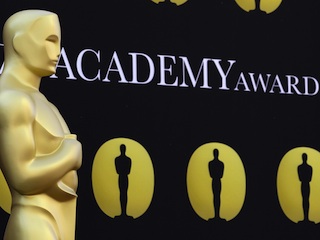Learning More about the Movies
By Frank W. Baker
 Every teacher I know uses “film” in the classroom, even if that film is a video or DVD. Effective teachers chose titles that supplement their instruction because they know that many of their students are visual learners.
Every teacher I know uses “film” in the classroom, even if that film is a video or DVD. Effective teachers chose titles that supplement their instruction because they know that many of their students are visual learners.
At my website The Language of Film, I’ve gathered and created many resources that educators can use to teach with and about film. In this article, I’d like to focus on ways teachers can help students learn more of the “about” of movie-making.
Very soon, the Academy of Motion Picture Arts & Sciences (AMPAS) will hand out the Oscars. And while most of us know about the actors and directors involved in major films, we know quite a bit less about the behind-the-scenes work of literally thousands of other people who participate in Academy-nominated motion pictures and make the stars shine.
If you’ve watched the credits of any film lately, then you know there are hundreds of people who work on any major movie. As much as the director or the actors, it is their specialized skills and talents that make film the magical medium it is.
Not long ago I took the time to really peruse the credit roll of a movie I enjoyed. It’s amazing to read the job titles — some of them quite mysterious to the general public (gaffers, grips, best boys and wrangler managers, to name a few). These people do not appear on the marquee nor on the poster promoting a film, but they do a lion’s share of the work. So much so that in Canada, with the help of familiar stars like Eugene Levy, a new campaign is underway to educate film audiences about the important roles these people play.
What in the world is a Foley artist?
Since I teach the “languages of film,” I want to help teachers and students become familiar with many of the people, jobs, skills and techniques involved in movie-making. One of the most intriguing and engaging movie jobs — certainly to tweens and young teens — is that of the Foley artist.
“Foley” (named after early sound artist Jack Foley) traces its roots back to the 1930s and the emergence of movies with talking actors and realistic background sounds.
“On the film set nothing is real — the sword is made of plastic, the marble floor is painted plywood. Foley replaces or enhances live sound; the result is a sword that rings like metal and floors that echo like marble!” — Art of Foley
“There are many stories in the film industry about Jack Foley’s genius, such as the time Stanley Kubrick wanted to re-shoot a Roman army scene in Spartacus to get the sound (of armor and metal) right — instead Foley jangled a set of keys into a microphone and got the desired sound. — mediacollege.com

In this L.A. Times Working Hollywood profile, Hecker describes the screen as his canvas. Yet he does not paint; instead, he recreates or invents sound. In this video feature you will see Hecker working on both Twilight and The Hunger Games. In another illustrative video clip — from the SoundWorks collection at Vimeo — you’ll see him create a sound sequence of Russell Crowe riding a horse in 2010’s Robin Hood.
In an interview with the PBS Newshour, Hecker described his job:
I work on a stage and they project an image of the film that we’re working on onto a screen, and I have live microphones and hand props and different things that I use to create sound effects. I watch the picture and mimic movements of the actors and also whatever is being portrayed on the scene of the film.
In another interview for the Los Angles Times, he further explained:
I have to also have a very creative mind. I’m out here in this studio, and I only have so many props to deal with. And sometimes on the screen, I don’t have that exact prop that the actor is using. So I have to come up with other things that suffice to make that sound.
There are two Oscar award categories that involve audio (excluding music): Sound Editing and Sound Mixing. Although Hecker is not nominated for an Oscar this year, he and his staff have been honored in the past for their work in films and television, including Django Unchained (2012) and War of the Worlds (2005).
In the truest sense, Foley artists are “filmmakers” — as are the lighting experts, set designers, screenwriters, storyboard artists, costume and makeup experts, and individuals in dozens of other roles. The Academy recognizes some of these film-making contributions among its 24 Oscar awards, including Original Screenplay, Adapted Screenplay, Editing, Cinematography, Production Design, Costume Design, Sound Editing, Sound Mixing, Visual Effects, Makeup and Hairstyling, Original Score, Original Song. (The other Oscars go to Best Picture, Director, Actor, Actress, Supporting Actor, Supporting Actress, Foreign Language Film, Animated Feature Film, Short Film, Animated Short, Documentary, and Documentary Short.)
The Academy also recognizes important “out of the limelight” advances in motion picture science and technology at an annual ceremony several weeks before the red-carpeted main event. And there are also student Academy Awards given (since 1972) to the best work of college students in the United States.
The AMPAS Film Education Curriculum
Several years ago, the Academy of Motion Picture Arts & Sciences created a complete film education program which is available in the Education and Outreach section of the Academy’s website. The series of Teacher’s Guides cover topics like screenwriting, cinematography, art direction, sound and music, costumes and makeup, and more. There’s also a cinema (media) literacy guide dubbed “Reading Between the Frames.”
Teaching Suggestion
Assign a student, or group of students, one of the Oscar categories for the current year. Bypass the actors and directors and limit their choices to the categories that involve movie professionals who work behind-the-scenes.
Have them choose a nominated person or team and use their research skills to create a multimedia profile of both the scope of work represented by the category (e.g., makeup and hairstyling, film editing) and short bios of the individual(s) nominated. Other than the current film, what else has the person (or team) done? What makes their work meaningful? What kind of college or career education might be required to do award-winning work in the category?
That memorable film
We can all recall favorite films — ones that we never tire of watching. There is something special and specific about such films that make them noteworthy. And behind their memorable scenes stand dozens of film artists and technicians who came together as a team to produce your out-of-the-ordinary viewing experience.
The next time you’re watching one of your favorites, take a few moments to scan those closing credits. Use Google or visit the Internet Movie DataBase (IMDB) and look up the people involved in those aspects of the film you most enjoyed — the foley artist, music composer, film editor, costume designer, etc. — and explore their careers. It’s a great way to not only find other movies you might enjoy but to gain a greater appreciation for an old movie cliché we often hear actors say: “I couldn’t have done it without all the people who collaborated to make this movie possible.”




































